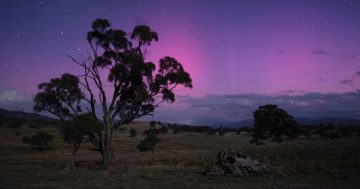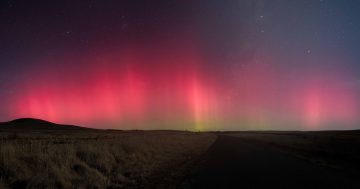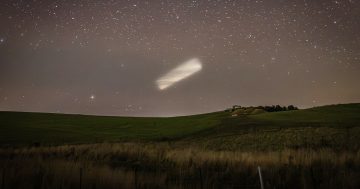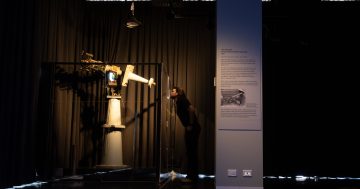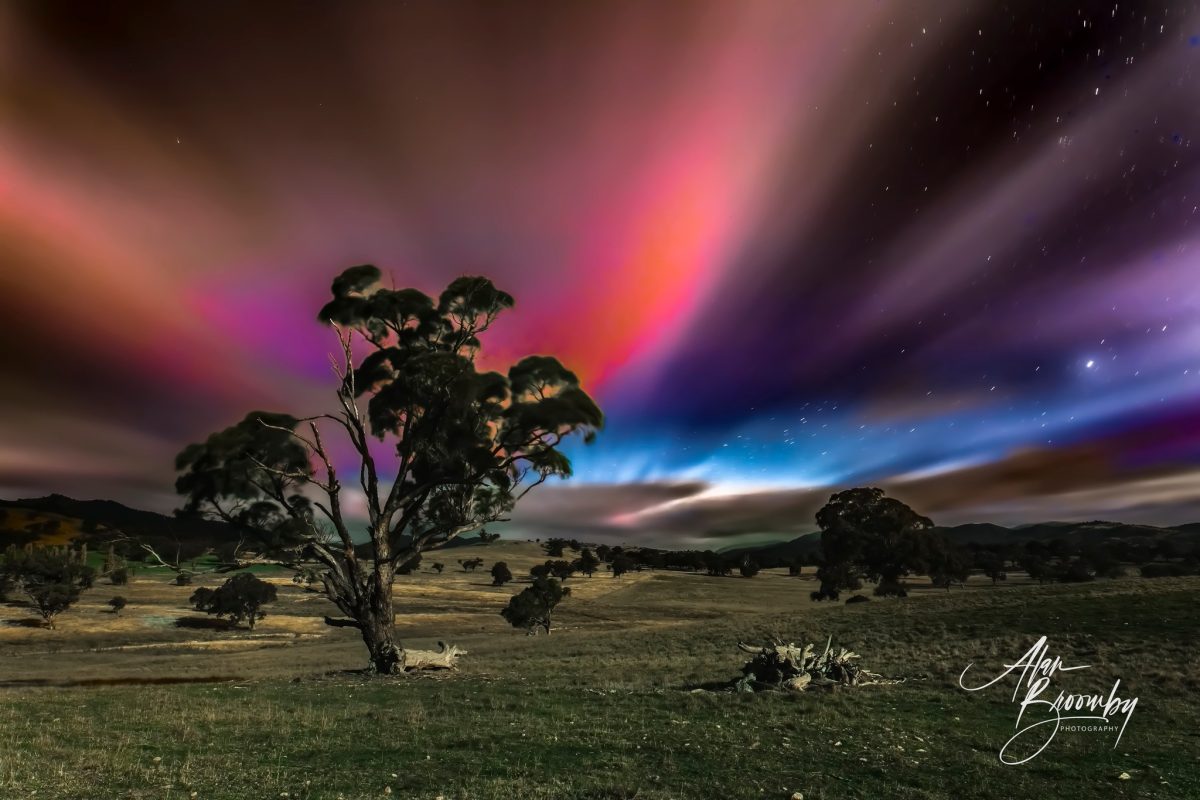
The aurora australis, near Williamsdale, as captured by Canberra photographer Alan Broomby. Photo: Alan Broomby.
Every 11 years, the sun gets in a bad mood and lashes Earth with searing gas and plasma. It’s happening right now, and some of Canberra’s most dedicated photographers have been braving the wet and cold nights to capture the results.
Technically, the ‘Solar Cycle’ is to blame for the mood swings and the lashes, known as ‘Coronal Mass Ejections’ (CMEs).
The sun’s magnetic north and south poles flip ends every 11 years, and the result is a period of intense activity – think more sunspots and solar flares, and here on Earth, awe-inspiring light shows called ‘auroras’.
“The aurora is generated by storms leaving the sun,” Australian National University (ANU) astrophysicist Dr Brad Tucker explains.
“Eruptions of heated gas and plasma travel through space and hit our Earth’s atmosphere. This plasma has a lot of electrical energy which excites and causes the gasses in our atmosphere to glow.”
The aurora borealis, or northern lights, originate from around the Arctic Circle, and the aurora australis, or southern lights, originate from around Antarctica. During surges in the sun’s activity like we’re experiencing now, however, their field of influence grows, too.
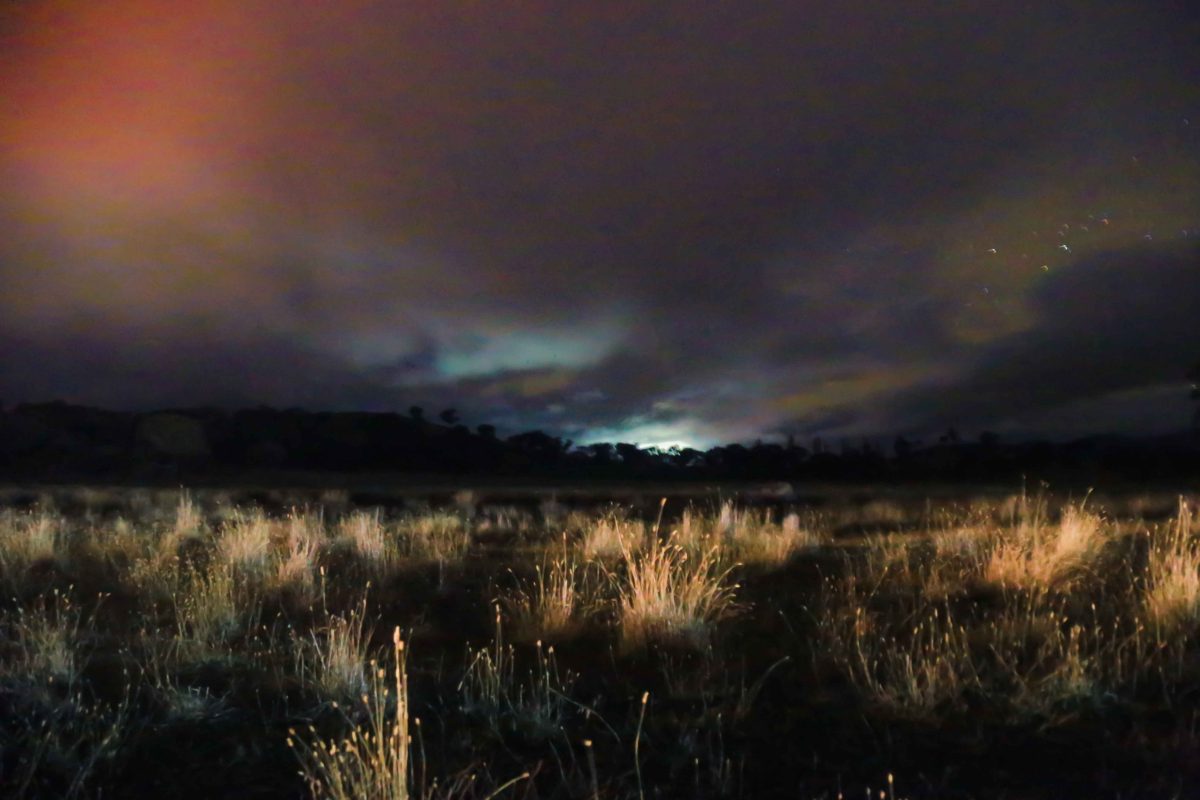
Southern lights captured from Williamsdale Road, around 9:50 pm, Sunday, 12 May. Photo: Region.
“The storms recently have been very strong, and the more energy you have, the more of the atmosphere will glow,” Dr Tucker says.
“It enters into the poles and extends towards the equator from there, depending on how much energy it has.”
Large bursts have been known to disrupt radio waves, internet connections on Earth, and even electricity grids. For instance, in October 2003, a solar storm caused blackouts in Sweden and damaged power infrastructure in South Africa.
That’s why the US National Oceanic and Atmospheric Administration (NOAA) issued a rare solar storm warning on Friday and upgraded it to “extreme” shortly after.

Southern lights captured over Yass. Photo: Screenshot, Yass Notice Board, Facebook.
The current solar cycle began in 2019, and scientists predict it will peak sometime in 2024 or 2025 before the sun returns to a lower level of activity in the early 2030s. For now, though, Dr Tucker says it’s in the “very active period” of the 11-year cycle.
This has led to sightings of the aurora australis from as high up in Australia as Mackay in Queensland, which is why people all over the southeast of Australia are staying up late or getting up very early to catch it. And yes, that includes Canberra. Sort of.
“When the aurora does happen around Canberra, heading south is best,” Dr Tucker says.
“You want the darkest view possible, so south of Canberra means the city lights are behind you.”
South-side photographer Alan Broomby has stayed up past midnight and headed to Williamsdale many times over the years to capture the aurora australis. But he describes the weekend as “the largest display I’ve seen in 20 years or longer”.
There might have been clouds and rain, but he says the colours have been so “intense” over the past few days that they’ve easily penetrated the cover.
“It would have been more visible for the guys who actually had clear skies … but you could see the bright red even through the clouds.”

Not even the clouds could stop it from coming through. Photo: Alan Broomby.
Williamsdale is a regular haunt for Alan, who runs astrophotography courses with Canberra Photography Workshops, but he also visits Bredbo and parts of the Namadgi National Park. He says the rain, “freezing cold” and hit-and-miss results are all worth it.
“It’s magic. The first time you see it – most people say the same thing – it brings tears to your eyes. It’s something that’s so phenomenal that you’ve never been able to capture before.”
Dr Tucker predicts the show will go on for some time yet, even if most of the biggest storms are over.
Thinking of heading out for a look? The BOM’s Australian Space Weather Forecasting Centre and NOAA websites publish regular aurora forecasts.












